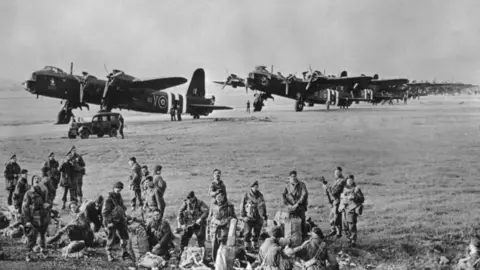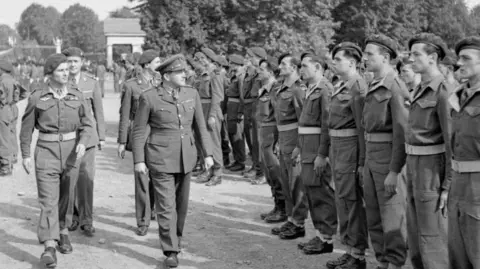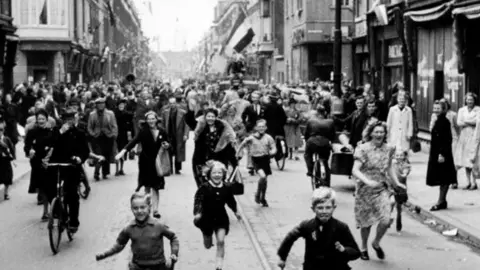Final WW2 airborne op 'testament to RAF skills'
 Getty Images
Getty ImagesThe last European airborne operation of World War Two was "testament to the skills of the RAF crews" based at Essex and Suffolk airfields, according to a local historian.
British-led French SAS soldiers were dropped into the German-occupied eastern Netherlands on 7 and 8 April 1945, suffering 18% casualties in fierce fighting.
The men were tasked with creating mayhem until the First Canadian Army pushed north to meet them and liberate the last part of the country under occupation.
RAF Rivenhall expert Chris Bullock said Operation Amherst was the first time parachutists were dropped above cloud cover.
 Getty Images
Getty ImagesThe mission utilised an RAF navigation system not previously used with "live loads".
"It was called Gee and it's basically a transponder that picks up signals from different transmitters to plot where they are," he said.
Previously, it had been used only for dropping cargo or for co-ordinating aircraft attacks on specific locations.
Mr Bullock said there was "0% visibility" due to heavy clouds, so the 702 paratroopers from 3rd and 4th Battalions were dropped from a far greater height than planned.
 Getty Images
Getty ImagesMr Bullock, who served with 3rd Battalion, Parachute Regiment for 25 years, lives near Rivenhall and has been researching its wartime history for more than 10 years.
He said: "The fact is they didn't know how to get that many paratroopers into the aircraft at one time with all their equipment, and the RAF crews were trying to figure it all out on the night."
The British-planned operation involved 47 aircraft taking off from two other Essex airfields, Great Dunmow and Earls Colne, as well as from Shepherds Grove in Suffolk.
Halifax bombers from Earls Colne were large enough to carry Jeeps, which were also dropped into the Netherlands.
 Getty Images
Getty ImagesThe country had been occupied since May 1940, but by this stage of the war parts of the country had been liberated.
But the Dutch had suffered through the Hunger Winter as a result of the German decision to stop all food transports to the west of the country – 20,000 people died of starvation – as well as exceptionally cold conditions, while many thousands were displaced.
"The objective of Amherst was to disrupt the German rear lines so the Canadian Second Army, advancing from the south, could relive them within 48 hours," said Mr Bullock.
Some of the highly-experienced British-trained men fought on for up to six days in the northern province of Drenthe before they could be relieved.
"This is why the casualties were exceptionally high – 28 were killed, 39 were wounded and 57 were missing in action," he said.
But their objective was achieved and, less than a month later, Victory in Europe was declared.
Follow Essex news on BBC Sounds, Facebook, Instagram and X.
